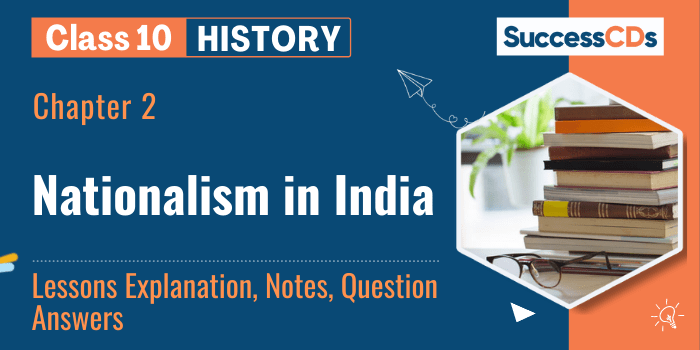CBSE Class 10 History Chapter 2 Nationalism in India Notes, Video Explanation and Important Question Answers from India and the Contemporary World Book
Nationalism in India Class 10 Notes – Here is CBSE Class 10 History Chapter 2 Nationalism in India Notes and Detailed explanation of the chapter ‘Nationalism in India Class 10’ along with question answers. Given here is the complete explanation of the lesson, along with all the exercises, Nationalism in India Questions and Answers given at the back of the lesson.
Topics Covered in CBSE Class 10 History Chapter 2 Nationalism in India are The First world war, khilafat and non-cooperation, differing strands within he movements, towards civil disobedience, the sense of collective Belonging with Video Explanations
Nationalism in India Class 10 Notes
Section 1 Events and Processes
- The First World War, Khilafat and Non- Cooperation
See Video Explanation - Differing Strands within the Movement
See Video Explanation - Towards Civil Disobedience
See Video Explanation - The Sense of Collective Belonging
See Video Explanation - MCQs for Class 10 History Chapter 2 Nationalism in India
- NCERT Solutions for Class 10 History Chapter 2 Nationalism in India
- CBSE Class 10 History MCQ Questions
- CBSE Class 10 Civics MCQ Questions
- CBSE Class 10 Geography MCQ Questions
- CBSE Class 10 Economics MCQ Questions
- NCERT Solutions Class 10 SST Important Question Answers
As we have read in the section 1, the concept of nationalism in Europe came aligned with the formation of new states. It also impacted on the mindset of the people of Europe. They were able to understand their identity and sense of belonging. New symbols and icons, new songs and ideas related to nationalism developed new links and redefined the boundaries of communities.
In most parts of the world the making of nationalism was a long process but here the question arises as to how it emerged in India?
India was a colony under British rule. So were some other countries. The growth of modern nationalism in such countries was related to the anti-colonial movement. As all people irrespective of their religion or social group were being oppressed by the colonial rule, they developed a feeling of unity among themselves. They felt a bond because of the oppression being faced by them. This led to the unity in their struggle against the colonial rule. Though social groups came together in the desire of getting freedom from the oppression but still their idea of freedom was not always the same. The congress under Mahatma Gandhi tried to bring along these groups within one movement. But the unity did not emerge without conflict.
So, here we will discuss about the rise of nationalism in India during 1920s.
1.The First World War, Khilafat and Non- Cooperation
The years after 1919 saw the national movement spreading to the new areas. It started involving new social groups developing new ways of struggle. So, what were these developments and what impact did they have?
Let’s discuss this
During the First World War, the expenditure on defence had increased to a great extent. The British government in order to finance the world war levied huge taxes and duties on the Indians. During the war years (1913-1918) the prices of the goods doubled up, all this led to extreme hardships for the common people. The other reason behind the anger of the commoners was the forceful recruitment of the villagers into the army.
Nationalism in India Part 1 Video Explanation
Nationalism in India Related Links –
| Nationalism in India Explanation | Nationalism in India MCQs |
In 1918-1919 and 1920-21 situation became worse due to the failure of crops in many parts of the country, this led to the increase of food prices. Later on people faced the epidemic of influenza. As per the census of 1921, 12 to 13 million people died because of the famines and the epidemic.
Top
The people of India thought that once the war will end their hardships will also come to an end. But that never happened.
At this stage Mahatma Gandhi appeared as a new leader who suggested a new way of struggle against the British rule. His idea was to do Satyagraha .So what is Satyagraha? Let’s discuss about this.
The idea of Satyagraha
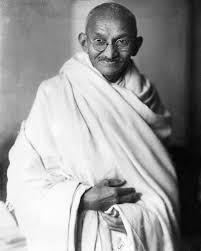
Mahatma Gandhi came back to India in January 1915. Before this, he used to live in South Africa where he had gained success in fighting against the injustice of racial discrimination. For this he chose a new method of mass agitation, but in a peaceful manner. This came to be known as Satyagraha.
The idea of Satyagraha laid emphasis on the power of truth and the need to search for truth. The main philosophy behind the idea of Satyagraha was that if the cause was true and the struggle was against injustice, then there was no need to apply physical force to fight against the oppressor. The battle could be won through non-violence by appealing to the conscience of the oppressor. People including the oppressor were convinced to see and accept the truth. Mahatma Gandhi believed that this dharma of non- violence could unite all Indians.
After his arrival in India in the year 1915, Mahatma Gandhi successfully carried satyagraha movements at different places. In 1917 he organized Satyagraha in Champaran (Bihar) to fight for the cause of peasants who were being oppressed by the indigo planters. Then in 1918 he organized Satyagraha to help the peasants of Kheda district of Gujarat. The government in Kheda was confiscating lands of the landowners for non- payment of tax. Whereas the landowners had already expressed their inability to pay it due to the crop failure caused by the famine. In 1918 he also undertook Satyagraha movement against the cotton mill workers.
Confident with the past success, Gandhiji decided to launch a nationwide Satyagraha against the proposed Rowlatt Act of 1919. Here the question arose as to what was Rowlatt act? Well, The Rowlatt Act of 1919 enabled the British government could detain any political prisoner for a term of 2 years without any trial. This act had been hurriedly passed by the Imperial Legislative Council though it was opposed by the Indian members. This act gave the British government enormous powers to repress political activities.
Mahatma Gandhi decided to have a non-violent civil disobedience movement against such unjust laws. He decided to begin it with a hartal on 6 April. Rallies were organized in various cities, workers of the railway workshops went on strike. In order to suppress this upsurge the British government decided to clamp down on nationalists. The government started picking up local leaders from Amritsar and Mahatma Gandhi was barred from entering Delhi. On 10th April the police took a harsh step of firing upon a peaceful procession in Amritsar. This provoked people resulting into attacks on banks, post offices and railway stations. The government imposed martial law which means that there would be direct military control of normal civilian functions. General Dyer was given the command.
On 13th April 1919, a large crowd gathered in the enclosed ground of Jallianwala Bagh. Some had come to protest against the new laws and measures of the government and some had come to attend the Baisakhi fair. Some of those who had come to attend the fair were outsiders and were not aware of the martial law imposed in the area. Dyer blocked the exit area and opened fire on the crowd. Hundreds of men and women were killed, including children. Later Dyer declared that his objective behind the massacre was to create terror in the minds of satyagrahis
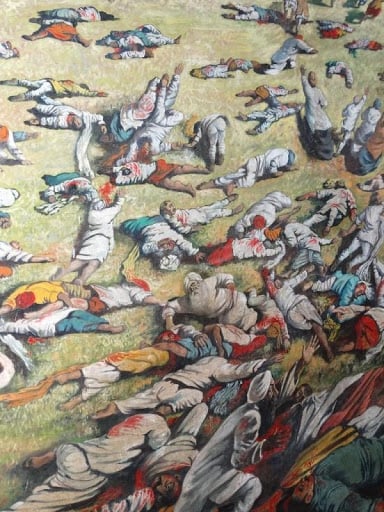
Soon the news about Jallianwala bagh broke out. Crowds took to the streets in many North Indian towns. There were strikes, protests, clashes with the police. Even the government buildings were attacked. To this the British government responded in a very brutal manner. People were both physically and mentally tortured. The nationalists were humiliated as they were forced to rub their noses on the ground, crawl on the streets and salute to all sahibs.
Not only this, people were flogged (beaten) and villages (around Gujranwala in Punjab, now in Pakistan) were bombed. On seeing the violence being spread, Mahatma Gandhi called off the movement.
Though the Satyagraha was a widespread movement, it was restricted to cities and towns only. Therefore, Mahatma Gandhi decided to launch a more broad-based movement in India. At this moment he also thought of bringing Hindus and Muslims together so as to make this movement certain and more realistic.
To make it work, he decided to take up the Khilafat issue. So, what was Khilafat movement?
During the First World War the Ottoman emperor of Turkey was defeated by the Britishers. He was known as the Khalifa, a spiritual head of the Muslim world. A news was spread that Khalifa was forced to sign a harsh peace treaty by the Britishers. This had caused anger among the Indian Muslims. To defend the Khalifa’s temporal powers, a Khilafat committee was formed in Bombay in March 1919 by Muhammad Ali and Shaukat Ali. Both the brothers discussed with Mahatma Gandhi about the possibility of a united mass action on the issue. Gandhiji found it to be an opportunity to bring Hindus and Muslims together for a unified national movement. So, in Calcutta session of Congress in September 1920, he convinced other leaders for this and a non cooperation movement was started in support of Khilafat as well as for Swaraj.
Till now we have come to know what Satyagraha was. how it was organized and we have also learnt about the idea of non cooperation movement in support of Khilafat as well as for Swaraj (self government).
But here the question comes is why non-cooperation was chosen by Gandhiji? What was the purpose of launching this movement? So, let’s see check this?
Why Non-cooperation?
As per the famous book Hind Swaraj (1909) Mahatma Gandhi declared that British rule came into being because of the cooperation by Indians. He was of the view that if Indians had refused to cooperate, the British rule in Indian will come to an end in a year and Swaraj would find its way.
To materialize the movement, Gandhiji decided to work on it in stages. So, it was done in the following manner:
- At first the titles awarded by the British government were to be surrendered by the people.
- Boycott of civil services, army, police, courts and legislative councils, schools and foreign goods.
- If in case the government uses repression then a full civil disobedience campaign was to be launched.
Mahatma Gandhi and Shaukat Ali toured extensively through the summer of 1920 to gain support for the movement.
On the other hand, there were some members of Congress who were not ready to support this movement. They were not in favour to boycott the council election which was to be held in November 1920. Most of them were afraid of any incident of violence. So, in the months between September and December there was a situation of tussle among the members of Congress. But in the Nagpur session of Congress in December 1920 a compromise was worked out and this led to the adoption of the non-cooperation movement.
Though this movement started at a national level but people involved in it had their own perspective.
2. Differing Strands within the Movement
The non-cooperation-Khilafat movement started in January 1921. Different social groups took participation in this movement, but each had his own aspiration. Though all of them responded to the call of Swaraj but their outlook for Swaraj was different from each other.
So, how it differed we will see now
Nationalism in India Part 2 Video Explanation
The Movement in the Towns
In towns, the movement started with the middle-class participation. A large number of students left government controlled schools and colleges. Teachers, headmasters resigned and lawyers left their legal practices. Even the council elections were boycotted in most provinces except Madras. The justice party of Madras which was a party of non-Brahmins who participated in council elections as for them it was one way to gain some power which was generally vested only with Brahmins.
Soon the boycott of foreign goods was started, liquor shops were picketed and foreign cloth was burnt in bonfires. This badly affected the British government economically. The import of foreign cloth halved between 1921 and 1922. The value of the business was reduced to Rs 57 crore from Rs 102 crore. Not only this, the merchants and traders also refused to trade in foreign goods or finance foreign trade. With the spread of this movement, Indians began using Clothes produced in India. This led to the increase in production of Indian textile mills and handlooms.
But this movement could not sustain for a long period due to various reasons such as:
- Khadi was an expensive cloth which was not affordable for most of the households.
- Students who boycotted British institutes could not find a suitable substitute, hence, rejoined them.
- Similarly teachers and lawyers went back to their work.
So, such was the non-cooperation movement in the cities but what happened in the villages or the countryside? Let’s check this
Rebellion in the Countryside
The non cooperation movement spread in villages too. The struggle was joined by the peasants and the tribes also.
One such struggle was the peasant struggle of Awadh led by Baba Ramchandra- a sanyasi. Baba Ramchandra used to be an indentured (bonded) laborer in Fiji. He started a movement against the talukdars and landlords who demanded high rents and various forms of cesses from the peasants. Peasants had to work at landlord’s farms without any wages known as ‘begar’. The peasants had no right over the leased land, they were regularly evicted therefore they had no security of tenure.
The peasant movement initiated by Ramchandra demanded for lowering down of revenue and abolition of begar. At some places nai- dhobi bandhs were organized by the panchayats. It was a kind of strike by the barbers and the washermen in order to deprive off landlords from the basic services. In 1920, Jawaharlal Nehru went to the different villages of Awadh and tried to understand the problems being faced by the peasants. In October 1920 he formed Oudh Kisan Sabha. The Oudh Kisan Sabha was headed by Jawaharlal Nehru, Baba Ramchandra and a few others. Soon 300 branches were set up in the villages around the region. When Congress started the non cooperation movement in 1921, it also integrated the peasant struggle into the wider struggle. However, this movement later on turned into a different direction which was not acceptable to the congress. As the movement spread the peasants attacked the houses of talukdars and merchants. They looted the bazaars and took away the grains. Soon it was found that at many places local leaders had told peasants that it was instructed by Gandhiji that no taxes will be paid and land will be redistributed among the poor. The name of Gandhi was misused in this case.
Another such case where the message of Mahatma Gandhi and the idea of Swaraj was misinterpreted was Gudem hills of Andhra Pradesh. Here a militant Guerrilla movement spread in the early 1920s which again was not a form of struggle accepted by the Congress. The reason behind this struggle was the prevention law made by the colonial government that barred the tribals from entering into the villages for collection of fuel wood, fruits or to graze their cattle. Not only this, the government forced them to work as beggars for building a road. The leader of this tribal movement was Alluri Sitaram Raju who declared himself as a man with superpowers who could sustain even the bullet shots. The tribals who were impressed by him and proclaimed him to be an incarnation of God.
Raju was greatly inspired by Mahatma Gandhi, therefore he persuaded the tribals to wear khadi and give up drinking. But on the other hand, he did not believe in the philosophy of peaceful demonstrations. He believed that Indian could be liberated with the use of force and not the non-violence. The Guden rebels under him attacked police stations, attempt to kill the Britishers and used guerilla warfare techniques to achieve swaraj. Later on Raju was arrested and a death sentence was given to him in 1924. He was still considered as a folk hero.
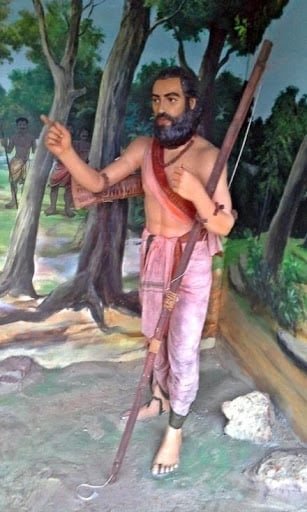
As we have read that everyone had his own way of interpreting swaraj so was the case of the Assam plantation workers who had their own idea of swaraj and non cooperation. So, what was that? Let’s see.
Swaraj in the Plantations
The workers of tea plantation had their own understanding of Swaraj. For them freedom meant the right to move freely in and out of their enclosed places. These workers were not allowed to move freely out of the tea gardens without permission. This was due to the inland Emigration Act of 1859 which bound them to follow this rule of confinement. They thought that non cooperation movement was a sign of the Gandhi Raj which would enable them to get free and own land in their own villages. Therefore they left the tea gardens and went back to their homes. However they were not able to do so as there was a railway and steamer strike. At last they were caught and beaten up by the police.
The movements carried by these groups were not included in the Congress programme. They made up their own interpretations and imagined it to be a time when all their hardships and troubles would end. Still when tribals raised the slogan of Swatantra Bharat and chanted Gandhiji’s name one could see the unified agitation of Indians in them. When they related themselves with the movement of Congress which was initiated by Gandhi, they were actually identifying with the movement which was far beyond their local areas.
Now that we know about the non cooperation movement and the way it was perceived by various groups. Let’s discuss about Civil Disobedience movement and how it started?
As the non cooperation movement was turning violent in many places, in February 1922 Gandhiji decided to withdraw the movement. He felt the need for proper training of satyagrahis before any kind of mass struggle. On the other side within the Congress were some leaders who were not in favour of any mass struggle. They decided to participate in the provincial elections which were set up by the Government of India Act of 1919. Their view was that they should oppose British policies within the councils and bring reform and also prove that these councils lack true democracy.
Nationalism in India Part 3 Video Explanation
C.R Das and Motilal Nehru were in favour of returning back to the council politics. Hence, they formed a Swaraj Party. But young leaders like Jawaharlal Nehru and Subhas Chandra Bose stressed on more mass struggles which present the agitation of Indians towards the oppressive policies of the Britishers and demanded for full independence.
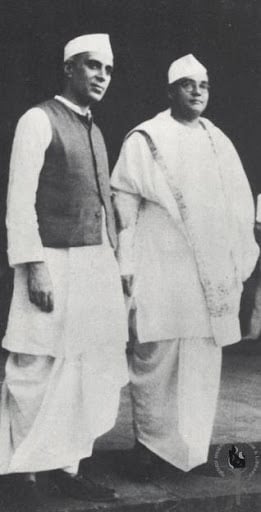
While there was a situation of internal debate and disagreement there were few factors that led to a change in the Indian politics during the late 1920s. Let us discuss what it was?
During the late 1920s, the world was facing the situation of economic depression. The price for agricultural goods fell and this led to the decline of exports. This fall in the prices began during 1926 and collapsed after 1930. It was a very hard time for the peasants, as they were not getting the right price for their produce, hence, they were not able to pay off the taxes. So, the situation of unrest was prevailing in rural areas by 1930.
On the other hand, the new Tory (Conservative party) government in Britain set up a commission under Sir John Simon. The commission was constituted of British members only, there was no Indian member in it. The main function of the commission was to look into the constitutional system in India and suggest reforms. As there was no Indian member involved so it was opposed by the Indians.
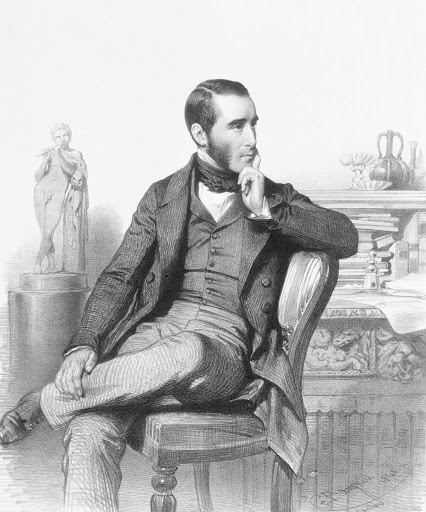
When the Simon Commission arrived in India, it faced opposition by people at various places who greeted them with the slogan ‘Simon Go Back’. Each and every party such as Congress and the Muslim league demonstrated against the Simon commission. Soon Britishers tried to pacify the situation by making an attempt to win back the loyalty of Indians. So, in October 1929, Lord Irwin came up with an unreal promise of granting ‘dominion status’ to India in an undetermined future. He also proposed for a round table conference to discuss a future constitution.
Soon the moderates who were proposing a constitutional system within the framework of British dominion lost their hold, whereas the radicals such as Jawaharlal Nehru and Subhas Chandra Bose gained more confidence. In December 1929, in Lahore session of Congress headed by Jawaharlal Nehru, the demand of Purna Swaraj. They decided to celebrate 26th January 1930 as the Independence Day of India. They also planned for a pledge by the people to struggle for complete independence. But this celebration was not able to attract much crowd. Mahatma Gandhi drew the conclusion that he needs to find a way in order to relate the idea of independence with important daily issues of common people.
When Mahatma Gandhi decided to find out a new way this led to the beginning of civil disobedience movement. So, what was the civil disobedience movement and why was the step of famous salt march carried on by Gandhiji. Let’s check this.
The Salt March and the Civil Disobedience Movement
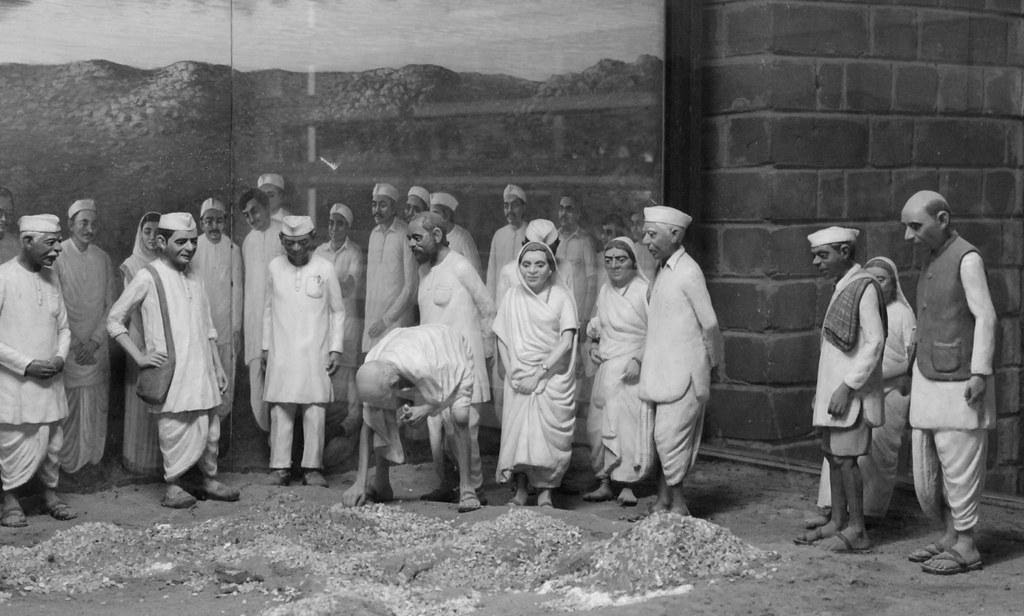
The first thing which Gandhiji thought was to unite people. This could only be done if the problems of all the classes of society to be taken into consideration So, with this view Gandhiji sent a letter to Viceroy Irwin on 31st January 1930 stating the eleven demands.
Some of these were of general interest; others were specific demands of different classes from industrialists to peasants. The main reason behind including demands of these groups was to bring everyone together in a united campaign.
The most important demand among all was the abolition of salt tax. Gandhiji gave a view that salt being an essential food item is consumed by all whether they are rich or poor. So, the tax on salt and the government’s monopoly over its production seemed unjust to him. Mahatma Gandhi declared this law as the most oppressive face of the British rule.
Mahatma Gandhi had given an ultimatum in his letter that if the demands would not be fulfilled by 11th March, the Congress will launch a civil disobedience movement. Lord Irwin did not consider it and this led to the beginning of non cooperation movement which was started with the famous Salt March led by Mahatma Gandhi. So, on 12th March Gandhiji started his famous salt march accompanied by 78 of his trusted volunteers. Gandhiji covered 240 miles in 24 days from his ashram Sabarmati to the Gujarati coastal town of Dandi. Thousands came to hear Gandhiji wherever he stopped. He explained to them about his idea of swaraj and urged them to carry the movement peacefully to defy the British. On 6th April Gandhiji reached Dandi and he broke the salt law by boiling sea water.
The Dandi March was seen as the beginning of the Civil disobedience movement. But here the question arises as to how it differed from the non cooperation movement?
The Civil Disobedience Movement differed in a way that in this case people not only refuse to cooperate with the British government but were also asked to break the British laws. So, this led to the following actions by the various groups in India:
- Thousands of people broke the Salt Law at various coastal areas. They manufactured salt and demonstrated in front of the government factories.
- Foreign cloth was totally boycotted.
- Liquor shops were picketed.
- Peasants start evading taxes. They stop paying revenues and chaukidari taxes.
- Village officials resigned.
- Forest laws were violated by entering into reserved areas to collect the wood and graze cattle.
The developments made under non cooperation movement terrified the British government. In order to control such activities, the government started arresting Congress leaders one by one. This resulted into ferocious clashes between the people and police. Abdul Ghaffar Khan a devout disciple of Mahatma Gandhi was arrested by the police in April 1930, this led to demonstration by the angry crowds in Peshawar. Police fired on the demonstrators and killed many of them. Later on Mahatma Gandhi was arrested this led to a violent demonstration by the industrial workers in Sholapur. They attacked the police stations, municipal buildings, law courts and railway stations. Here we can say that they tried to attack every symbol of British rule. As government got terrified with such incidents it became brutal with the peaceful satyagrahis. The government started attacking even the women and children about 1 Lakh people were arrested.
As the situation was growing worse so Gandhiji decided to call off the movement. On 5th March 1931 he entered into a pact with Irwin which later came to be known as Gandhi-Irwin Pact. Due to this pact Gandhiji agreed to participate in the round table conference. The first round table conference was boycotted by the Congress in London and the government consented to release the political prisoners. In December 1931 Gandhiji went to London to attend the round table conference but the conference failed and Gandhiji returned back with disappointment. When he reached India, he found that the government had initiated a new form of repression. Leaders like Ghaffar Khan and Jawaharlal Nehru were both in jail. Congress was declared illegal and various new measures were imposed by the government to prevent meetings, demonstrations and boycotts.
Gandhiji again launched the civil disobedience movement. It did continue for about a year but it soon lost its strength. What were the reasons behind the decline of this movement and what was the perception of the participants of civil disobedience movement. Let’s discuss this.
How Participants saw the Movement
To understand the reason that led people to participate in the movement, we first need to know the different social groups that participated.
Let‘s discuss the case of rich peasant communities of rural areas. The Patidars of Gujarat and the Jats of Uttar Pradesh had actively participated in the movement. They were the producers of cash crops hence were not much affected by the fall in prices of the agriculture products. As their cash income disappeared, they found it difficult to pay the government tax. So, for them participating in Civil Disobedience movement was equal to the reduction in the government revenue. They started organizing their communities for civil disobedience movement. Even those who were reluctant were also forced to participate. But when the movement was called off in 1931 without reduction in revenue, they felt really disappointed. Hence, they refused to participate in 1932, when the movement was started again.
On the other hand, the poor peasants who had small land holdings and were generally tenants were badly hit by the fall in the prices of food grains. They demanded for the cancellation of the revenue or the rent they had to pay. For this they organized for various radical movements under some socialists or communists. These peasants were never able to get support by the Congress as the party was unwilling to support ‘no rent’ campaigns as this might upset the rich peasants and landlords.
If we talk about the business classes and their relation with civil disobedience movement then for this we need to know about the condition of the business houses at that time.
During the First World War, the Indian businessmen and industrialists earned huge profits and became more powerful. How this happened will be discussed later in chapter 5. As they wanted to expand their business, they started reacting against the British policies that were against the expansion of business. They had their own issues such as protection of business from outside competition for this they demanded for protection against the imported goods. They also demanded for rupee-sterling foreign exchange ratio that would discourage imports.
The industrialists in order to demand for their rights formed up Indian Industrial and Commercial Congress in 1920 and the Federation of the Indian Chamber of Commerce and Industries (FICCI) in 1927. Indian industrialists under the leadership of some important industrialists like Purshottamdas Thakurdas and G.D Birla attacked the British control over the Indian economy and supported the Civil Disobedience movement when it was launched for the first time. They not only participated in it by refusing to buy or sell imported goods but also financially supported it. For most of them, Swaraj meant as a time when the British restrictions on business will be removed and the Indian trade and industry would flourish. But when it was revealed that the round table conference failed, the business groups no longer felt excited about the civil disobedience movement. They were worried about the spread of any militant activities that could disrupt the business and also were also not in favor of the growing socialism among the young Congress members.
So, now we know about the participation of industrialists and how they step back to participate in the movement but what about the industry workers?
Well the industrial workers did not participate in this movement. Only it was in Nagpur where the participation was seen among the workers. They followed the Gandhian programme of boycotting foreign goods as part of their own movements against low wages and inadequate working environment. So, for them their struggle was for adequate wages and good working environment. So there were strikes by railway workers in 1930 and dockworkers in 1932. In 1930 thousands of workers in Chotanagpur tin mines participated in rallies by wearing Gandhi caps. But in this case the Congress was not interested in including the demand of workers. It did so in order to keep industrialists with them so that the force against the British rule may not lose its strength.
Last but not the least was the participation by women in the civil disobedience movement. Women had participated at a very large scale. During Gandhiji’s salt march, thousands of women went to listen to him. They participated in protest marches, manufactured salt and picketed the liquor shops and foreign cloth shops. Many of them even went to jail. These women were either from high caste families in urban areas or from rich peasant households of rural areas. Inspired by Gandhiji, all the women took it as their sacred duty to participate in the national movement. Though this participation did not bring any change in their social status. Even the Congress was also reluctant in including women in their organization.
So, now we know about the participation of the different groups in the civil disobedience movement and also the reasons behind their reluctance to keep continuing with it. So, now let’s check the limits of civil disobedience.
The Limits of Civil Disobedience
Though various social groups had come along with Congress to participate in the Civil Disobedience movement but there were still many who were not moved by the abstract concept of swaraj. One such group was the untouchables. In 1930s they began calling themselves the Dalits or oppressed.
Initially Congress did not raise the issues of Dalits. They did so because they were not interested in offending the high caste conservative Hindus known as sanatanis. It was Mahatma Gandhi who declared that it is necessary to include the untouchables into the movement for achieving independence. He once said the swaraj would not come for a hundred years if untouchability was not eliminated. He called the ‘untouchables’ harijans, or the children of God.
Gandhiji led Satyagraha in favour of harijans, in order to secure entry for them into temples. He also fought for the basic rights of the harijans such as accessing to public wells, tanks, roads and schools. Not only this, he persuaded the uppers castes to change their perception and give away the evil of untouchability.
While all these struggles were going on for dalits. Some leaders who were from dalit community began organizing themselves for resolving various issues their communities were facing. For this they started demanding for reserved seats in educational institutions and a separate electorate so that they would choose dalit member for legislative council. The political dalit leaders believed that if they will be politically empowered, they can resolve the various problems of their community. Therefore the dalit participation in the civil disobedience movement was limited, particularly in the areas of Maharashtra and Nagpur where their organizations was quite strong.
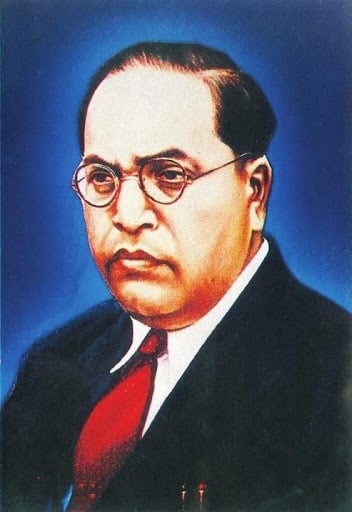
There were moments when the dalit demands clashed with the ideology of Swaraj. One such incident was the second round table conference held in (7 Sep 1931-1 Dec 1931) where Dr. B.R Ambedkar‘s demand of separate electorates for dalit clashed with Mahatma Gandhi’s philosophy. When the British government conceded Ambedkar’s demand, Gandhiji began a fast unto death. Gandhiji was of the view that separate electorates for dalits would slow down the process of their integration into society. At last Ambedkar accepted Gandhiji’s position and the result was the Poona Pact of September 1932. The Poona pact gave the dalits or scheduled castes the reserved seats in provincial and central legislative councils but there was a condition that they were to be voted in by the general electorate. Apart from dalits, the Muslims also later on felt alienated from the Congress. They had their own reasons for that.
There were some Muslim political organizations in India who were not so keen to be the part of the civil disobedience movement. This was due to the decline of the Non-cooperation-Khilafat movement in past. Most of the Muslims felt estranged with the Congress. It was so because in mid 1920s the Congress became more associated with Hindu religious nationalist groups like the Hindu Mahasabha. The relations between Hindus and Muslims were worsening day by day. Each community started organizing religious procession with militant zeal. All this led to the communal riots among Hindu- Muslims in various cities. Every riot deepened the distance between the two communities.
While the distance was deepening among the communities, the Congress and the Muslim League tried to negotiate an alliance. It seemed during 1927 that such a unity was possible but the main reason behind the differences was over the representation in the future assemblies that were to be elected. In the beginning Muhammad Ali Jinnah, one of the leaders of the Muslim League was willing to give up the demand for separate Muslim electorates. He made a condition of granting Muslims with reserved seats in the Central Assembly and representation in proportion to population in the Muslim dominated provinces such as Bengal and Punjab. Muslim League had expected that this issue will be resolved at the All Parties Conference in 1928. But this issue was not resolved due to the strong opposition by M.R. Jayakar of the Hindu Mahasabha.
So, when the civil disobedience movement started in 1930 there was an atmosphere of distrust among the communities. As the demand of Muslims was not accepted so large sections of Muslims did not come forward for a united struggle. Even many of the Muslim leaders and intellectuals were generally concerned about the status of Muslims as a minority within India. They doubted that their culture and identity will be submerged by the Hindu majority.
So, now we know that various movements of struggle were initiated by different groups with different mindset. Later all these groups began to separate from each other due to one reason or another but how the idea of unity and nationalism emerged in such a situation then. Let’s discuss this.
4. The Sense of Collective Belonging
Nationalism as we know spreads when people feel commonness among themselves. This happens when they believe that they belong to the same nation. But the question arises that how the people from different communities who have different beliefs, languages and culture will come together to make the idea of nation a reality?
Nationalism in India Part 4 Video Explanation
Well, this sense of collective belonging came due to some reasons like through their experience of united struggle or because of the variety of cultural processes through which nationalism captured people’s imagination. History and fiction, folksongs and folkdance, popular prints and symbols plays a vital role in making the nationalism.
The identity of a nation is generally symbolized in the form of a figure or image. This helps in creating an image with which people can relate. So, in the twentieth century as the nationalism was growing in our country, the identity of Indian came to be visualized as Bharat Mata. To start with, it was Bankim Chandra Chattopadhyay who created the image through his poem ‘Vande Matram’. He wrote this poem in 1870 in which he wrote a hymn for his motherland. Later this poem was added in his novel Anandmath and was widely sung during the swadeshi movement in Bengal. Later Abanindranath Tagore painted and image of Bharat Mata. He painted her as an ascetic. She looks calm, divine and spiritual. In following years Bharat Mata was painted into different forms. Different artists painted her in their own way. The painting was circulated in popular prints. Soon the devotion to this mother figure came to be seen as evidence of one’s nationalism.

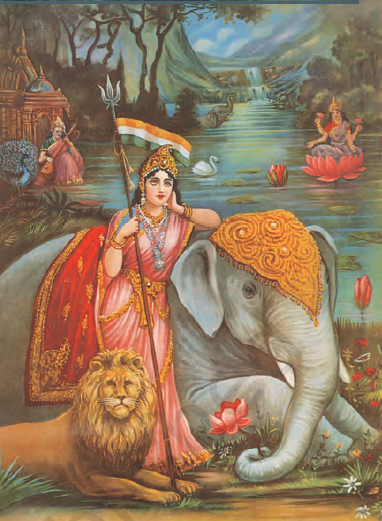
The idea of nationalism not only developed with the female depiction of India but also through the Indian folklore. During the late nineteenth century many nationalists began the collection of various folk songs, Folktales and legends that were sung in villages across India. They did this in order to preserve their folk tradition which was the original culture of India which was damaged by the outsiders. Various prominent figures felt it as a need of an hour to preserve the folk lore in order to restore a sense of pride in one’s past.
In Bengal, Rabindranath Tagore began collecting ballads, nursery rhymes and myths and in Madras, Natesa Sastri published a massive four-volume collection of Tamil folk tales, the Folklore of Southern India. Both of them were of the view that the folklore is the true demonstration of the people’s real thoughts and characteristics.
In the later years as the national movement developed, various nationalist leaders chose symbols or icons to generate the feeling of nationalism and unification among the Indians. For instance, during the swadeshi movement in Bengal a tricolor flag (red, green and yellow) was designed. The flag had eight lotuses which represented the eight provinces of British India. It also had a crescent moon that was used to represent the Hindus and Muslims. Even Gandhiji also designed a swaraj flag. His flag was also tricolor having red, green and white with a spinning wheel in its centre. The spinning wheel represented the Gandhian ideal of self-help. During those days, carrying a flag during the protest or March symbolised the resistance against the British rule.
Another idea which was used to create a feeling of nationalism was our own past i.e. our history. Many of the Indians began feeling that to instill a sense of pride in the nation; Indian history had to be thought about differently. As we all know that Britishers saw Indians as backward and incompetent to govern themselves, therefore various writers started writing about the glorious Indian past. They wrote about the developments that took place in the past in various categories such as architecture, science and mathematics, religion and culture, law and philosophy, crafts and trade etc. They explained how our glorious past declined with the coming of the colonial rule in our country. The writers urged the readers to struggle in order to bring back the glory of our country and to end the oppressive British rule in India.
The various efforts made to unify people were also somehow got connected with the controversies. It was so because when the past was glorified it was connected with the Hinduism even the images were also drawn from Hindu iconography. Therefore the people from other communities felt left out.
Conclusion
So at last we can say that a growing outrage towards the oppressive rule of the colonial government was the main reason that brought all the people of India together to initiate a common struggle for freedom in the first half of the twentieth century. The Congress under Mahatma Gandhi tried to channelize the problems of people into organized movements for independence. With the help of these movements he tried to forge a national unity among the Indians but as we have read in the chapter that various groups joined the struggle with their own perceptions and aspirations, a situation of differences between these groups arise. Congress made several attempts to keep these groups together but there were such times when the differences grew so strong that it became difficult for the Congress to keep these groups together. So here we can say that it was a time when a new nation was emerging with various people demanding freedom from colonial rule.
Nationalism in India Questions and Answers
Q1-Explain:
- Why growth of nationalism in the colonies is linked to an anti colonial government.
- How the First World War helped in the growth of the National Movement in India.
- Why Indians were outraged by the Rowlatt Act.
- Why Gandhiji decided to withdraw the Non-Cooperation Movement.
A1- a) The growth of nationalism in the colonies is linked to an anti-colonial movement because the countries which were under control of the various imperialist countries were facing oppression and hardships due to their colonial masters. Hence when nationalism grew in these countries they made unified attempts of struggle to release themselves from the clutches of the colonial government.
b) The First World War had created a situation of economic crisis. The war had increased the defence expenditure of the government. To bear this expenditure the government increased the taxes and duties leading to the burden on the Indians. The prices of food were increased and the government started forceful recruitment of villagers into army. Even if there was a crop failure and an epidemic broke which took away the lives of so many people. All these hardships lead to the growth of nationalism among the Indians and helped in the growth of the national movement in India.
c) The Rowlatt Act of 1919 gave enormous powers to the government to repress the national movements in India. As per the act the government could detain any political prisoner for two years without any trial. For Indians this law was unjust and highly oppressive and hence they were against this law.
d) Mahatma Gandhi had to call of the Non cooperation movement because of the following reasons:
- It had turned violent in many places.
- Gandhiji felt that the Indians were not yet ready to practice the method of Satyagraha.
- Every participant had his own perception about swaraj. So he decided to first teach all the real meaning of Satyagraha and swaraj.
- The incident of Chauri-Chaura in U.P. Here a peaceful demonstration of satyagrahis was attacked by the police. The agitators then turned violent resulting into the burning of police station and killing of nearly 22 policemen.
Q2- What is meant by the idea of Satyagraha?
A2- Satyagraha was the novel method of mass agitation used by Mahatma Gandhi in South Africa during his struggle against racism. Satyagraha in true sense lays emphasis on the power of truth and the need to search for truth. It suggests that if the cause is true, if the struggle is against injustice then physical force is not necessary to fight the oppressor. A satyagrahi could win his battle with the help of non- violence itself. This could be done be appealing to the conscience of the oppressor so that he can see the truth and accept him without any coercion or use of violence.
Q3- Write a newspaper report on:
- The Jallianwala Bagh massacre
- The Simon Commission
A3- a) On 13th April 1919 a peaceful crowd had gathered in the Jallianwala bagh. Some of them had come there to protest against the repressive measures of the government and others had come to celebrate the Baisakhi Fair. Most of them were outsiders and were not aware of the imposition of Martial law in the city. General Dyer, the commander blocked the exit point of the bagh and opened fire on the innocent people. Hundreds of them including children and women were killed. This incident led to a nationwide rage and everyone turned against this brutal incident.
- The Simon commission was constituted under Sir John Simon. The aim of the commission was to look into the functioning of the constitutional system in India and suggest some changes. But it was opposed by many leaders in India because there was no Indian included as member of this commission. When the commission arrived in 1928 in India, it was greeted with demonstrations and the slogan of ‘Go back Simon’.
Q4- Compare the images of Bharat Mata in this chapter with the image of Germania?
A4-
- The image of Bharat Mata is portrayed in different manner by different artists. For example in the image painted by Abanindranath Tagore, Bharat Mata is shown as an ascetic figure. She is calm, composed and divine but in another image she is shown with Trishul, Standing beside a lion and an elephant. This image of her symbolizes power and authority.
- Germania is a female figure used for depicting Germany. She is shown standing against a background where beams of sunlight shines that depicts the bright future of Germany. She holds a tricolor flag in her hand and a sword in the other hand which shows strength. She is also shown wearing a crown of oak leaves because the German oak stands for heroism.
Also See :
Class 10 Social Science History Lessons
- Chapter 1 The Rise of Nationalism in Europe, Class 10 History Explanation, Question and Answers
- Chapter 3 The Making of a Global World, Class 10 History Explanation, Question and Answers
- Chapter 4 The Age of Industrialization, Class 10 History Explanation, Question and Answers
- Chapter 5 Print Culture and The Modern World, Class 10 History Explanation, Question and Answers
Class 10 Social Science Civics Lessons
- NCERT Class 10 Power Sharing Notes Chapter 1 Explanation
- NCERT Federalism Class 10 Notes | Civics Chapter 2 Explanation
- NCERT Federalism Class 10 Notes | Civics Chapter 6 Explanation
- NCERT Federalism Class 10 Notes | Civics Chapter 7 Explanation
